Top 5 Selling Platforms with the Lowest Fees for Online Sellers in 2024
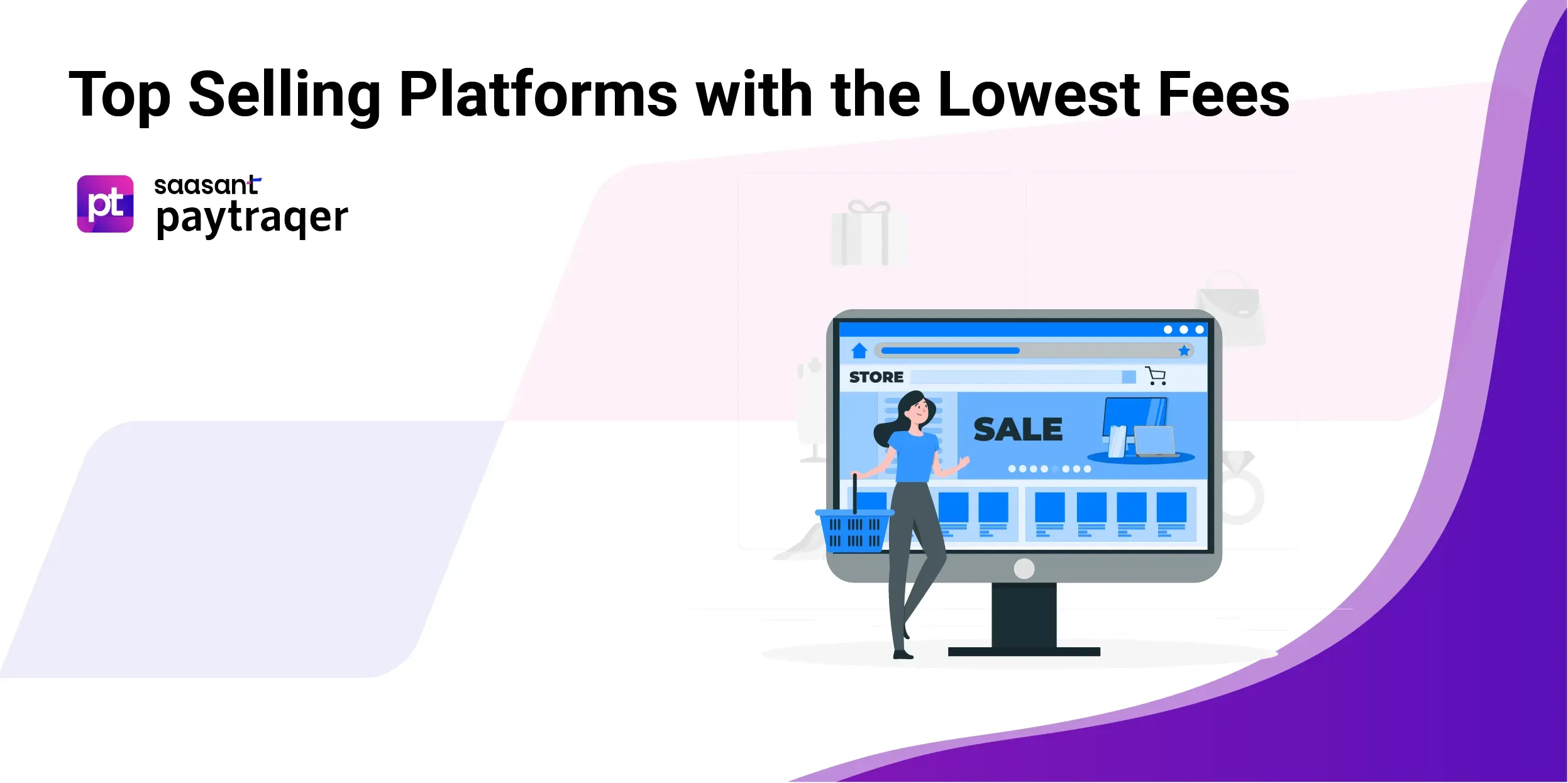
In recent years, the world of e-commerce has experienced a rapid surge in popularity, with more and more entrepreneurs turning to online marketplaces as their primary source of income. However, with this increased demand comes a rise in competition from other marketplaces, and online sellers are constantly looking for ways to maximize their profits while minimizing their expenses.
One of the most significant expenses for online sellers is platform fees, which can eat into their profits and make it challenging to stay competitive. That's why we've compiled a list of the top 5 selling platforms with the lowest fees for online sellers in 2024.
Whether you're just starting or looking to switch to a more cost-effective platform, this guide will provide you with the information you need to make an informed decision about the platforms with the lowest selling fee and a professional plan to take your business to the next level.
Contents
5 E-commerce Sites To Sell On
Which Platform is Best for Sellers?
Where Can I Sell My Stuff Online for Free
Online Marketplace Fees
Marketplace Fees Comparison
How to Sell Things Online and Make Money
I Want Someone to Sell My Stuff For Me
Choosing the Best Online Selling Platform and Managing Your Finances
Tips for Maximizing Sales: Strategies for Sellers
FAQs
5 E-commerce Sites To Sell On
There are numerous ecommerce sites where online sellers can list their products and sell them to customers. Here are some of the most popular ecommerce sites to sell on:
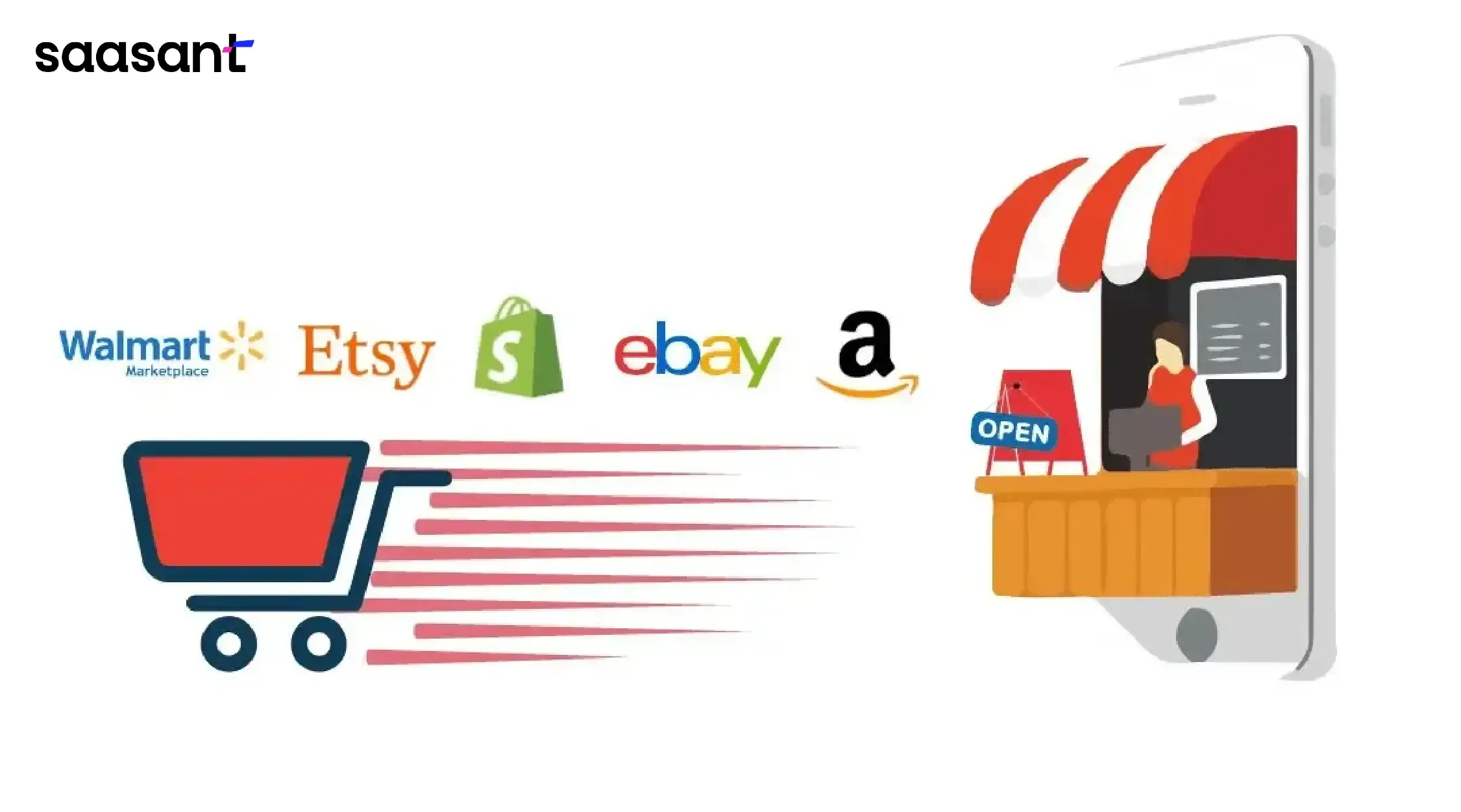
Amazon
Amazon is one of the world's largest online marketplaces, offering a platform for individuals and businesses to sell their products to a global audience. As an e-commerce business and site, Amazon provides many features and benefits to sellers looking to reach new customers and increase their sales.
To sell products on Amazon, a seller must create an account and list them on the site. Amazon offers two types of seller accounts: individual and professional. Individual sellers can sell up to 40 products per month. In contrast, professional sellers can sell an unlimited number of products and gain access to additional features like bulk listing and inventory management tools.
When sellers list their products on Amazon, they can choose to fulfill orders or use Amazon's fulfillment services. With Amazon's fulfillment service, Fulfillment by Amazon (FBA), the seller sends their products to an Amazon fulfillment center, where they are stored, packed, and shipped to customers on the seller's behalf. It allows sellers to focus on their business while Amazon handles the fulfillment logistics.
Unique Characteristics
Large customer base: Amazon has millions worldwide, so sellers can access a vast audience and increase their reach.
Ease of use: Amazon's seller platform is user-friendly and easy to navigate, making it simple for sellers to list their products and manage their orders.
Fulfillment services: Amazon's FBA service allows sellers to outsource their fulfillment, saving time and money on logistics.
Advertising options: Amazon offers a range of advertising options, including sponsored product ads, which can help sellers increase their visibility and sales.
Trust and credibility: Amazon has a reputation for reliability and trustworthiness, which can help sellers build trust with customers and increase their sales.
eBay
eBay is another popular ecommerce site that provides a platform for individuals and businesses to sell their products to a global audience. eBay differs from Amazon in that it allows sellers to sell new and used products and includes auctions as a selling format.
To sell on eBay, a seller must create an account and list their products on the site. eBay offers various seller accounts, including individual and business accounts. Individual sellers can sell up to 20 items per month for free, while business sellers pay a monthly subscription fee and can sell unlimited items.
When sellers list their products on eBay, they can either fulfill orders themselves or use eBay's fulfillment service or eBay Managed Delivery. With eBay Managed Delivery, sellers can send their products to eBay's fulfillment centers, where they are stored, packed, and shipped to customers on the seller's behalf. It allows sellers to focus on their business while eBay handles the fulfillment logistics.
Unique Characteristics
Substantial Clientele: With millions of active buyers across the globe, eBay provides sellers with a massive customer base and ample opportunities for increased sales.
Various selling formats: eBay offers various selling formats, including auctions, which can help sellers reach buyers looking for unique and hard-to-find items.
Seller protection: eBay offers protection programs that protect sellers from fraudulent buyers and other potential issues.
Advertising options: eBay offers various advertising options, including promoted listings, which can help sellers increase their visibility and sales.
International selling: eBay allows sellers to sell their products to buyers worldwide, providing sellers with access to new markets and customers.
Shopify
Shopify is an ecommerce platform allowing individuals and businesses to create online stores to sell their products to customers worldwide. Shopify is a fully hosted ecommerce platform that lets you create ecommerce websites. It handles the technical aspects of running an online eBay store, including hosting, security, and payment processing.
To sell on Shopify, a seller must create an account and choose a pricing plan. Shopify offers various pricing plans, including Basic Shopify, Shopify, and Advanced Shopify. Each plan comes with different features and pricing, and sellers can choose the plan that best fits their needs.
Once a seller has created their account, they can customize their online store using Shopify's easy-to-use website builder. Shopify offers a range of customizable themes and templates, making it simple for sellers to register a custom domain and create a professional-looking online store that reflects their brand.
Unique Characteristics
Fully hosted platform: Shopify takes care of the technical aspects of running an online store, including hosting, security, and payment processing, which makes it easy for sellers to focus on their business.
Low Code Interface: Shopify's website builder is easy to use and requires no coding experience, making it simple for sellers to create a professional-looking online store.
App integration: Shopify offers a range of app integrations, including marketing and advertising apps, which can help sellers increase their sales and grow their business.
Multiple sales channels: Shopify allows sellers to sell their products on various channels, including social media platforms like Facebook and Instagram, which can help sellers reach new customers and increase their sales.
Payment processing: Shopify offers a secure payment processing system that allows sellers to accept payments from customers worldwide.
Etsy
Etsy is an ecommerce platform focused on handmade and vintage goods and unique and creative items. The platform offers a marketplace for sellers to connect with buyers worldwide interested in purchasing unique and one-of-a-kind products.
To sell on Etsy, a seller must create an account and list their products on the site. Etsy charges a listing fee for each product that is listed on the platform and a commission fee for each sale that is made. The commission fee is a percentage of sales proceeds or the total sale price, including all shipping costs and handling.
Etsy offers various tools and resources to help sellers grow their businesses, including marketing and advertising tools, seller support, and community forums.
Unique Characteristics
Unique marketplace: Etsy provides a unique marketplace for sellers who create handmade or vintage items craft supplies, and sell unique and creative products.
Large customer base: Etsy has a large and engaged customer base, providing sellers with increased visibility and sales potential.
Seller tools and resources: Etsy offers a range of tools and resources to help sellers grow their businesses, including marketing and advertising tools, seller support, and community forums.
International selling: Etsy allows sellers to sell their products to buyers worldwide, providing sellers with access to new markets and customers.
Branding opportunities: Etsy allows sellers to build a strong brand presence on the platform, including creating a custom shop banner and logo and linking to social media accounts and websites.
Walmart Marketplace
Walmart Marketplace is one of the best ecommerce platforms that allows third-party sellers to sell their products on Walmart's website. Walmart is one of the largest retailers in the world, and Walmart Marketplace offers sellers access to a large and diverse customer base.
To sell on Walmart Marketplace, a seller must apply and be approved by Walmart. Once approved, the seller can list their products on the platform and manage their orders, shipping rates, and inventory through Walmart's seller center. Walmart charges a referral fee for each sale, and sellers are responsible for their shipping rates and handling.
Walmart Marketplace offers a range of tools and resources to help sellers grow their businesses, including marketing and advertising tools, seller support, and educational resources.
Unique Characteristics
Substantial Client Pool: Walmart is one of the largest retailers in the world, and Walmart Marketplace offers sellers access to a large and diverse customer base.
Trusted brand: Walmart is a trusted and well-known brand, which can help sellers build credibility and trust with customers.
Marketing and advertising tools: Walmart Marketplace offers a range of marketing and advertising tools to help sellers promote their products and reach new customers.
Seller Support: Walmart Marketplace provides sellers with dedicated support and educational resources to help them grow their businesses.
Competitive fees: Walmart's referral fees are generally lower than other ecommerce platforms, which can help sellers maximize their profits.
Which Platform is Best for Sellers?
Determining which platform is best for a seller depends on various factors, such as the type of products they sell, their target audience, and their business goals. Here are some considerations for choosing the best platform for a seller:
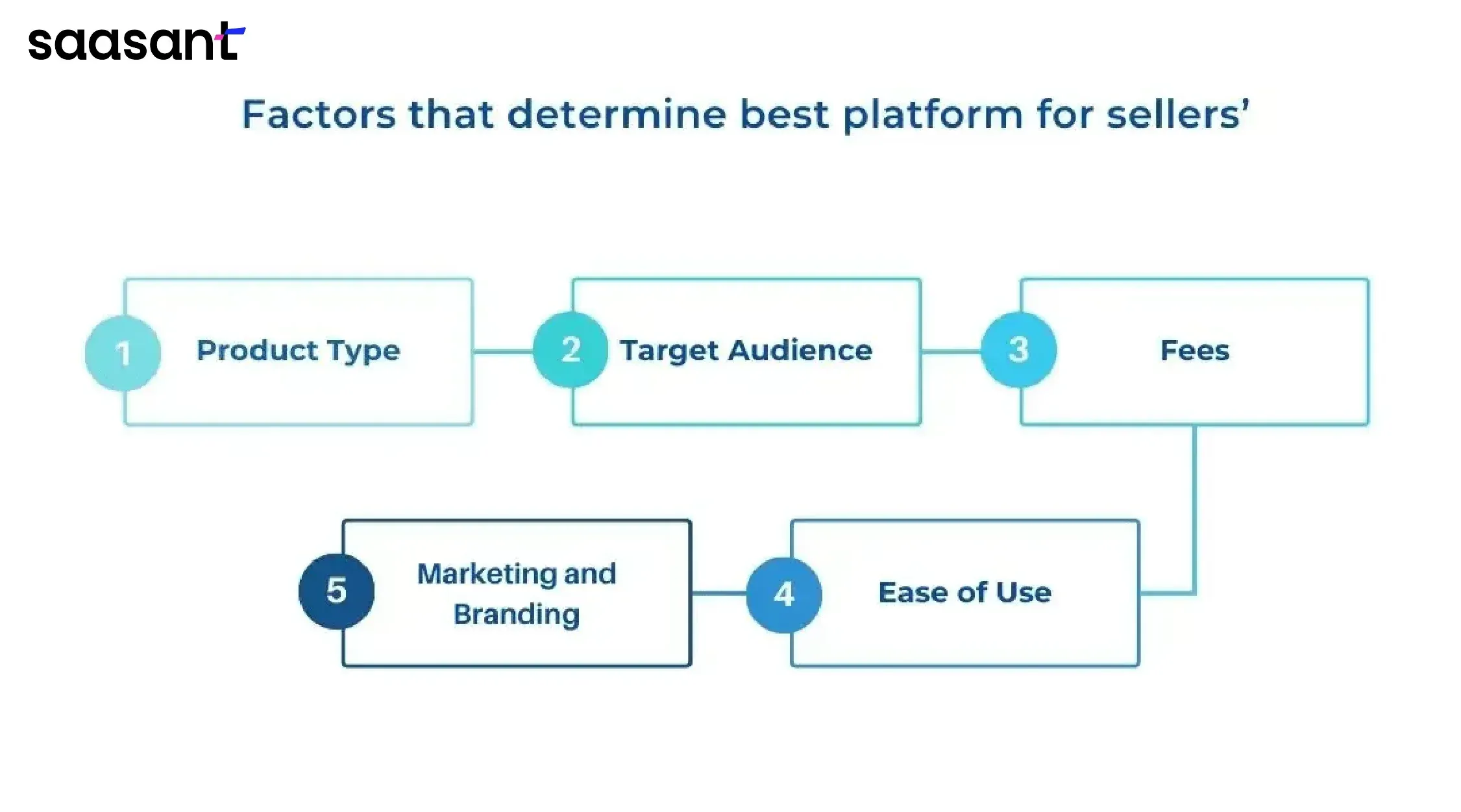
Product Type
Specific platforms, like Etsy or eBay, are better suited for selling handmade or vintage items. In contrast, others, like Amazon or Walmart Marketplace, are better for selling a wide range of products.
Target Audience
Different platforms attract different types of customers. For example, Amazon is known for its broad customer base, while Shopify allows smaller sellers to create their online store and control the customer experience.
Fees
Each platform charges fees for selling on their platform, which can vary depending on the platform and the type of product being sold. Sellers should consider the various fees and how they impact their profit margins.
Marketing and Branding
Some platforms allow sellers to market and brand their products more effectively than others. For example, Shopify will enable sellers to control their branding and marketing efforts, while Etsy has a built-in community of buyers looking for unique and personalized products.
Ease of Use
Some platforms are easier to use, with more user-friendly interfaces and easier integration with other tools and platforms.
Where Can I Sell My Stuff Online for Free
There are several platforms where you can sell your stuff online for free. Here are some of the best options:
Facebook Marketplace
Facebook Marketplace is a free online marketplace that allows you to buy and sell items locally. All you need is a Facebook account to get started. You can create a listing for your item, add photos and a description, and set a price. Buyers in your local area can browse your listing and contact you if interested. You can negotiate the price and arrange payment and delivery directly with the buyer.
Ebid
Ebid is an online marketplace where you can buy and sell items. It was founded in the UK in 1998 and has since expanded to other countries. Ebid aims to provide a low-cost alternative to other online marketplaces, with lower seller fees and no listing fees. Sellers can list items for sale in various product categories, including clothing, electronics, and home goods. Buyers can browse listings and make offers or purchase items directly. Ebid also has a bidding system for auctions, similar to eBay.
Craigslist
Craigslist is a popular classifieds website where you can sell your items for free. It's organized by city so that you can post your listing locally. You can include photos and a description of your item, and interested buyers can contact you directly. Craigslist doesn't offer payment or delivery options, so you must arrange that directly with the buyer.
Letgo
Letgo is a mobile app that allows you to list and sell items to local buyers for free. You can take a photo of your item, add a description and price, and list it on the app. You can also create a photo collage and include multiple pictures presenting your item. Interested buyers can contact you through the app, and you can negotiate the price and arrange for payment and delivery directly with the buyer.
OfferUp
OfferUp is another mobile app that lets you sell your items locally for free. You can list your item by taking a photo, adding a description and price, and posting it on the app. Buyers in your local area can browse your listing and contact you if interested. You can negotiate the price and arrange payment and delivery directly with the buyer.
Mercari
Mercari is a mobile app that allows you to list your items for free. You can create a listing for your item, add photos and a description, and set a price. Buyers can browse your listing and make an offer, which you can accept or reject. Mercari offers payment and shipping options, so you can receive payment and ship your item directly to the buyer. However, Mercari does charge a 10% commission on each sale.
These platforms allow you to sell your stuff online for free, each with unique features and benefits. You can choose the platform that best suits your needs and preferences to sell your items quickly and easily.
Online Marketplace Fees
Online marketplaces typically charge fees to sellers for using their platforms to sell their products. These fees vary depending on the platform and the type of product being sold. Here are some standard fees you may encounter when selling on an online marketplace:
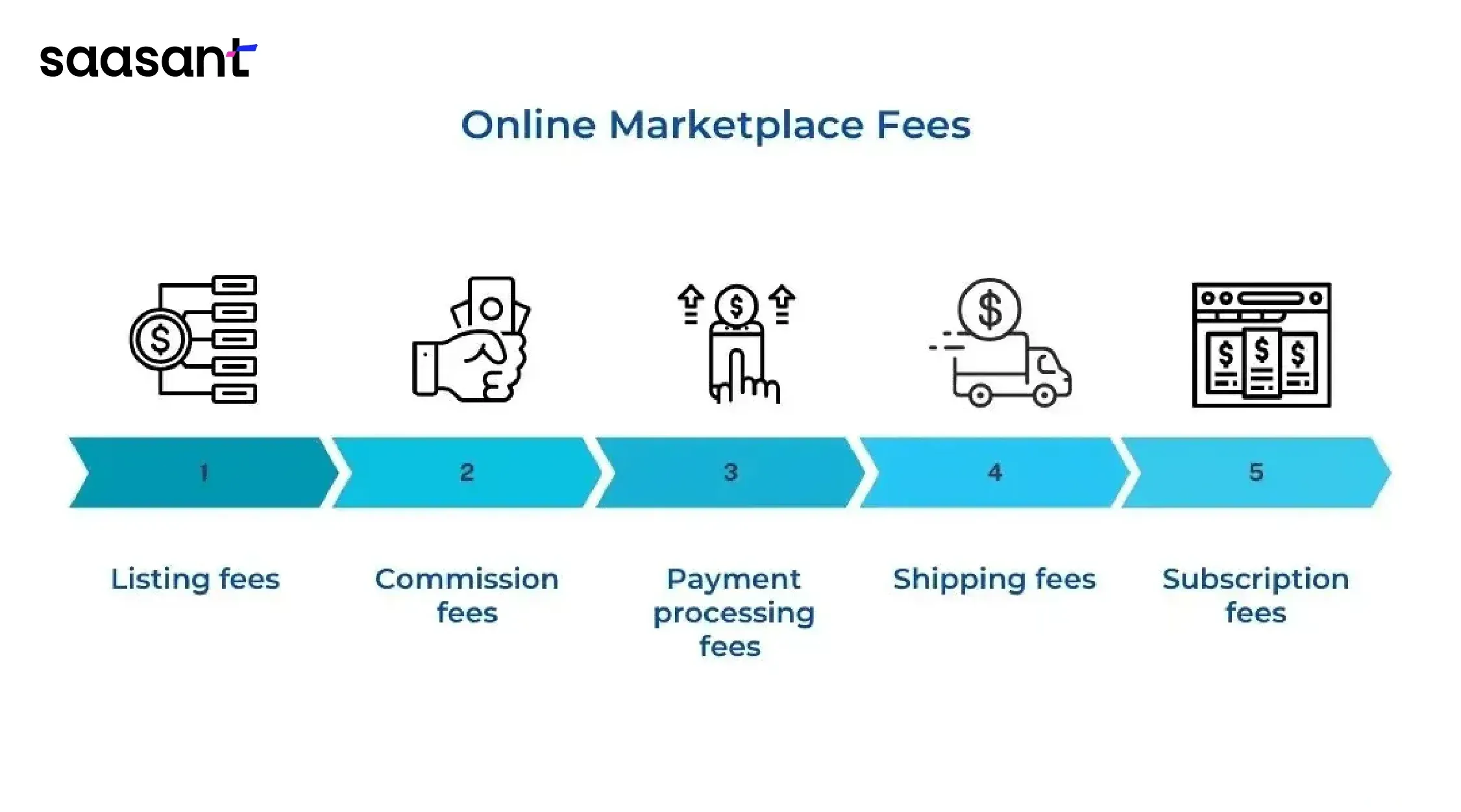
Listing fees
Some online marketplaces charge a fee for each item listed for sale. This fee is usually a fixed price, regardless of whether the item sells.
Commission fees
Many online marketplaces charge a commission fee on each sale made through their platform. This fee is usually a percentage of the total sale or sales price and can range from 2 to 15% depending on the platform and the category of the item being sold.
Payment processing fees
Online marketplaces often charge a payment processing fee for processing transactions through their platform. This transaction fee is usually a percentage of the sale price, ranging from 2-5%.
Shipping fees
Some online marketplaces offer shipping services to sellers and charge a fee. The fee can vary depending on the weight and size of the item being shipped.
Subscription fees
Some online marketplaces offer premium services to sellers for a monthly fee or annual fee. These services may include access to advanced selling tools, analytics, and marketing features.
If you're looking for an online selling platform with the lowest fees to conduct your online business, here are four options to consider:

Mercari
Mercari is a mobile app-based selling platform that charges a flat 10% commission fee on all sales. However, they offer new sellers a "no fee" promotion for their first ten sales.
Poshmark
Poshmark is a fashion-focused selling platform that charges a flat 20% commission fee on sales over $15. For sales under $15, there is a flat $2.95 commission fee. However, they offer a reduced commission rate of 10% on items that sell for $15 or less during "Posh Parties."
Depop
Depop is a fashion-focused selling platform that charges a flat 10% commission fee on all sales. However, they offer a reduced commission rate of 5% for sellers who participate in their Depop+ subscription service.
eBay
eBay charges a variable commission fee based on the item sold category. Fees can range from 2-12% of the total sale of item price alone. However, eBay offers a certain number of free listings per month, and if you exceed that number, they charge the maximum fee of a flat 35-cent listing fee per item.
It's important to note that while these platforms may have lower fees than other online selling platforms, they may have a different level of traffic or exposure than larger platforms. It's essential to carefully consider your options and choose the platform that best meets your needs as a seller.
Marketplace Fees Comparison
Here's a table comparing the fees of five popular online marketplaces:
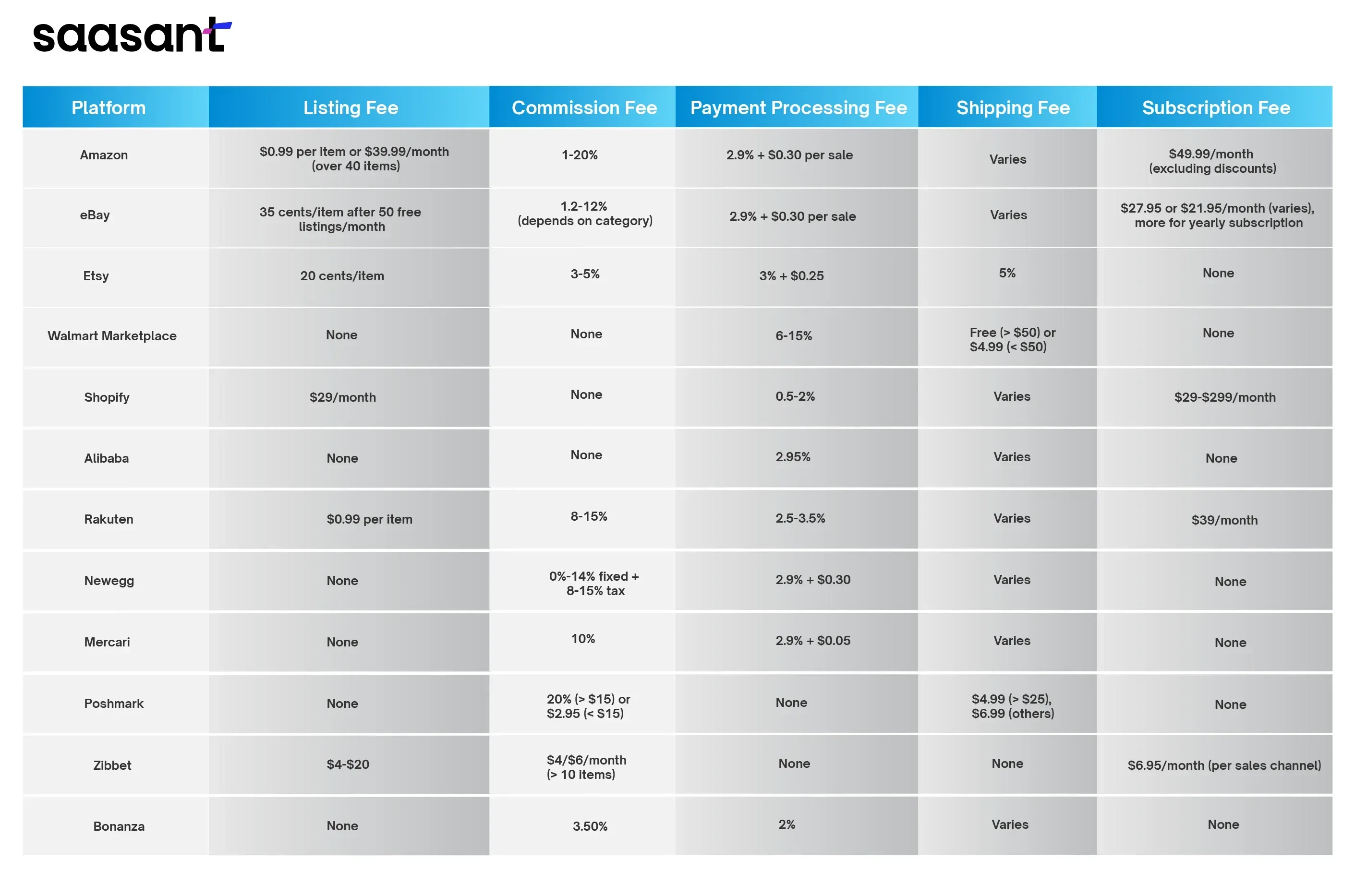
Note: Please remember that the fees listed are subject to change and may vary depending on the specific product category and features used on each platform.
How to Sell Things Online and Make Money
Selling things online can be a great way to make money, whether you want a full-time income or just some extra cash. Here are some steps to get you started and start selling online:
Step 1. Choose your platform
Decide which online marketplace or platform you want to sell your items. Many options are available, from popular paid sites like Amazon, eBay, and Etsy to newer platforms like Facebook Marketplace and Mercari.
Step 2. Set up your account
Once you've chosen your platform, create an account and set up your seller profile. It may involve providing personal and financial information, such as your name, address, and bank account details.
Step 3. List your items
Take clear and detailed photos of your items and write accurate descriptions to help attract buyers. Set a fair price that reflects the item's condition, age, and market demand.
Step 4. Manage your inventory
Keep track of your inventory and update your listings when items sell or become unavailable. Consider using ecommerce accounting software with inventory management to help streamline this process.
Step 5. Promote your listings
Share your listings on social media, use relevant keywords in your titles and descriptions, and offer promotions or discounts to help attract buyers.
Step 6. Communicate with buyers
Respond promptly to any inquiries or messages from potential buyers, and be courteous and professional throughout the selling process.
Step 7. Ship your items
Once a sale is made, package and ship the item promptly and securely. Consider using shipping labels when offering free shipping or a shipping calculator to the total sales price to ensure you're charging the right amount.
Step 8. Get paid
Keep track of your earnings and receive payment from your platform or directly from the buyer. Some platforms may have fees or commissions that will be deducted from your earnings, so be sure to factor that into your pricing strategy.
I Want Someone to Sell My Stuff For Me
If you want someone to sell your stuff for you, you have a few different options:
Consignment shops
Many consignment shops will sell your items for you in exchange for a percentage of the sale price. It can be a good option if you have high-end or unique items that may need help to sell on your own.
Auction houses
Auction houses can help you find a place to sell items through live or online auctions. They typically take a commission on the sale price but can be a good option if you have rare or valuable items.
Online consignment stores
A growing number of online consignment stores, such as The Real and thredUP, will sell your items for you online. They will typically take a percentage of the sale price but can be a good option if you have high-end or designer items. In addition, you can use the Fulfillment by Amazon (FBA) service, where Amazon is responsible for storing, packing, and shipping your products to the customer’s location.
Virtual assistants
You can hire a virtual assistant to help you sell your items online. They can create listings, manage your inventory, and communicate with buyers on your behalf. However, you'll need to pay them for their time and expertise.
Friends or family
If you have friends or family members who are experienced at selling things online, you could ask them to help you. They may be willing to sell your items for a small fee or a percentage of the sale price.
Remember that when you hire someone to sell your items, they will likely take a commission or fee, so you may make less money than if you sold the items yourself. However, if you need more time or expertise, it can be an excellent way to sell your items quickly and easily.
Choosing the Best Online Selling Platform and Managing Your Finances
Selling online can be a great way to make extra money or start a full-time business. With so many online marketplaces available, knowing which one best fits your needs can take time and effort. In this comparison, we've looked at some of the top online marketplaces and their fees so you can make an informed decision.
Whether you're looking to sell online on a large platform like eBay or Amazon or prefer a niche marketplace like Etsy, there are plenty of options. Facebook Marketplace and Craigslist can be excellent options for selling locally, while Ebid offers a lower-cost alternative to other online marketplaces.
In addition to choosing the right marketplace, keeping track of your transactions and finances is essential. PayTraQer is an automated bookkeeping application that can help you manage your finances, like sales, refunds, and fees, and enables you to reconcile your books for effective financial management. PayTraQer lets you stay on top of your finances and ensure you make the most of your online sales. With this automation application, you can get your e-commerce transactions flowing into QuickBooks and Xero quickly.
Tips for Maximizing Sales: Strategies for Sellers
Pricing Strategies:
Conduct thorough market research to understand pricing trends for similar products on the platform.
Consider offering competitive pricing while maintaining profitability.
Utilize dynamic pricing strategies to adjust prices based on demand, competition, and other market factors.
Offer discounts, promotions, and bundling deals to attract customers and incentivize purchases.
Regularly review and adjust pricing strategies based on performance and market dynamics.
Product Photography:
Invest in high-quality product photography that showcases your items in the best light.
Use a clean and clutter-free background to highlight the product.
Include multiple angles and close-up shots to provide a comprehensive product view.
Ensure proper lighting to capture accurate colors and details.
Consider incorporating lifestyle or contextual images to demonstrate product use and benefits.
Product Descriptions:
Write clear, concise, and compelling product descriptions that highlight key features and benefits.
Use relevant keywords and phrases to improve search visibility and ranking.
Include accurate dimensions, specifications, and other relevant details to set clear expectations for customers.
Address potential customer questions or concerns proactively within the description.
Consider using storytelling techniques to engage customers and create emotional connections with your products.
Customer Engagement Tactics:
Respond promptly to customer inquiries, messages, and feedback to provide excellent customer service.
Personalize interactions with customers to create a positive shopping experience.
Encourage customer reviews and feedback to build social proof and credibility.
Implement cross-selling and upselling techniques to suggest complementary products or upgrades.
Leverage social media platforms to engage with customers, share product updates, and drive traffic to your listings.
Platform-Specific Strategies:
Amazon: Optimize product listings with relevant keywords, utilize Amazon's advertising and promotion tools, and leverage Fulfillment by Amazon (FBA) for streamlined logistics and enhanced visibility.
eBay: Utilize auction-style listings for unique or rare items, offer competitive shipping options, and participate in eBay's promotional events and deals.
Etsy: Showcase your products' handmade and unique aspects, participate in Etsy's community forums and events, and leverage Etsy's search and discovery features.
Shopify: Customize your online store design to reflect your brand identity, utilize Shopify's built-in marketing and SEO tools, and integrate with third-party apps to enhance functionality.
Walmart Marketplace: Focus on product quality and value, optimize product listings for Walmart's search algorithm, and participate in Walmart's advertising and promotional initiatives.
FAQs
What Platforms Can I Sell On For Free?
You can sell for free on platforms like Facebook Marketplace, Craigslist, and Letgo. These platforms do not charge listing fees or commissions on sales.
What Is the Cheapest Selling Website?
The cheapest-selling website will depend on the fees charged by each platform. However, platforms like Facebook Marketplace and Craigslist do not charge selling fees, making them the cheapest.
What are the Best Online Selling Sites
Some of the best online-selling sites include eBay, Amazon, and Etsy. These online selling platforms have large user bases (millions) and offer a variety of features and products online to sellers and buyers.
What is the Most Popular Selling Site?
The most popular selling sites are eBay, Amazon, and Walmart Marketplace, each with millions of users and a wide range of products. Facebook Marketplace is also becoming increasingly popular for selling items locally and reaching a more targeted audience.
What is the final value fee?
A final value fee is a charge imposed by ecommerce platforms on sellers for each successful transaction. It's typically a percentage of the item's final selling price. This fee covers using the platform's services to facilitate the sale.
How does the final value fee vary on different ecommerce sites?
The final value fee can vary from one ecommerce site to another. Some platforms charge a flat percentage, while others have tiered pricing based on the item's category or price range. The site's popularity, features, and target market can influence the fee structure.
Are there additional fees besides the final value fee on ecommerce sites?
Yes, besides the final value fee, ecommerce sites may impose other charges. These can include listing fees, subscription fees for premium features, payment processing fees, and promotional fees for boosting visibility. Sellers need to review the fee structures of different platforms to understand their overall cost of doing business.